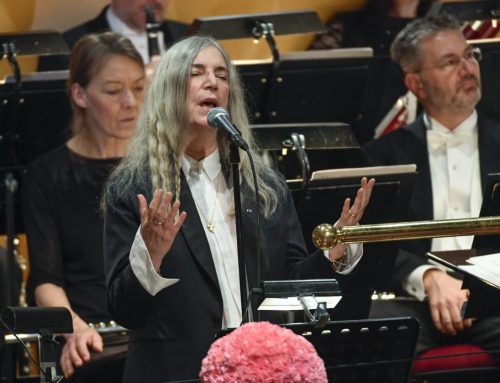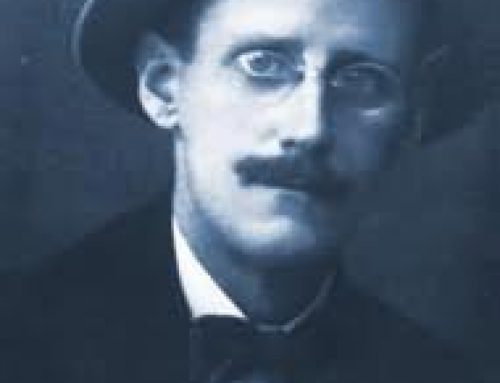Homeric link/lien avec Homère: Nestor
Place/lieu: The school/l’école
Hour/heure: 10 a.m.
Color/couleur: Brown/maron
Body part/partie du corps: none/aucun
Art: History
Symbol: Horse/cheval
Episode 2 begins with Stephen teaching a history lesson at Mr. Deasy’s school in Dalkey. In Joyce’s schema, history is the art of this episode, and, appropriately, time takes priority over space, which was in ascendance in the previous episode.
Stephen’s interior monologue is growing more prevalent. Joyce does not yet use the technique for any other character.
In Homer’s “Odyssey,” Nestor is an old man, the senior charioteer, who dispenses “sage” advice to young Telemachus as he sets off in search of his long-lost father, Odysseus (Ulysses). As Stephen begins his quest, Deasy is Joyce’s “Nestor,” but he is a wellspring of only stale beliefs and rote learning, clinging to fixed ideas and identities. The headmaster is an Anglophile who collects shells, coins and apostle spoons, a willing subject under Britain’s colonial rule, a betrayer of the true self. His “knowledge” is empty of life; he holds to an illusion of self. Deasy offers Stephen “wisdom” of the past and future, but nothing of the present moment. He dwells in the past (as evidenced in his conservative political views and rigid notions of Ireland, England, Jews, etc.) and saves money for the future (encouraging Stephen to do likewise).
The symbol of the episode is the horse. Homer’s Nestor was a charioteer, and cared for horses. A horse is a noble animal serving an oppressive master. Stephen, like a horse, is “bridled and restless“ (Gilbert), yearning to be free, to become whole.
“History,” Stephen says, “is a nightmare from which I am trying to awake.” For him, history sucks the life out of the present moment. It organizes, categories and fixes all phenomena and beings, attempting to limit what has no limits, to define what cannot be defined. Stephen seeks to awaken to the present moment, to be free of delusion and the bonds of his “historic” false self.
It is 10 a.m. Stephen is setting forth on his path to the “now, the here,’’ teaching a history lesson on the battle of Tarentum, which resulted in Pyrrhus’s “victory” over the Romans, but at great human cost. Stephen sees that all ‘’victories’’ are indeed Pyrrhic.
The episode is steeped in layers of time: Caesar’s history in the lesson; Irish history in Deasy’s discourse. Stephen thinks of “spiritual history,” of Christ (“the might of Him that walked the waves”) whose shadow is “upon us all,” not bounded by time or space.
Time, clearly, is relative. Joyce reveals it in contrasts: Deasy is old, Stephen young; Stephen is old, the students young. Stephen observes his young student Sargent working his math problem and thinks, “Like him was I,” and “My childhood bends beside me.” He has a thought, too, of his mother, feeding and caring for him. But the past cannot be touched, he notes, it is “Too far for me to lay a hand there once and lightly.”
Everything about Deasy and his office is stagnant, fixed, unbending. “Per vias rectas,” Deasy says, which is Latin for “by straight roads.” For such a man there is no place for the 99 curves of the present moment.
The inattentive school boys are caught already in the culture of the false self — taught to memorize names, dates, places but not to experience the true nature of their beings and the universe, moving, moving, moving, “the joust of life,” “world without end” (or “whirled without end,” as Joyce wrote in “Finnegans Wake”). Like their headmaster, they learn by imitation, by copying, missing the essence.
Stephen’s debts, which he recalls mentally (p. 37, lines 25-31), are evidence of his effort to live in the present, the here and now, to hold to nothing. To Deasy’s question as to whether he can “feel” what it is to “owe nothing,” to proclaim like a proud Englishman, “I paid my way,” Stephen replies, “For the moment, no.’’ In the ever-changing moment, where not a thing is fixed, no such proclamation can be made. Stephen, a man of the spirit, of nonform, of now, rejects Deasy’s material world of accumulating — be it shells, coins or spoons, traditions of the past or funds for the future. Yet Stephen’s dire economic situation also reflects what he is missing: the “body” of life. With rotten teeth and second-hand clothes, unwashed and in debt all around, he is ignoring the material world, the concrete reality of sustaining one’s being. Debts leave traces every moment.
Deasy, however, misses the world of nonform, the fluid, ungraspable essence. He collects and reproduces only form, for only forms can be collected and reproduced. “I’ve put the matter into a nutshell,” Deasy tells Stephen. Indeed, he puts life in a shell, and his collection is just that: shells of life, dead, the “hard” exterior lacking the “soft” interior that cannot be seized, held, copied, or displayed for view. His coins are, in the words of Joseph Campbell, “concretizations of life energy,” and his apostle spoons empty relics of the “sacred.” This is to mistake the finger pointing at the moon for the moon.
Stephen has a passing thought of Vico Road, a posh street in Dalkey. One of Joyce’s fundamental inspirations (along with Homer, Dante, Bruno and Shakespeare) was the Italian philosopher Vico and his notion of cyclical return (ricorso). Thus, the Greek Nestor can manifest centuries later as an old Irish schoolmaster. This is akin to the Buddhist notion of reincarnation and the circle as manifestation of absolute reality. This theme runs throughout “Ulysses” and is brought to majestic fruition in Joyce’s final work, “Finnegans Wake.” “As it was in the beginning, is now,” Stephen thinks.
He contemplates the past and ponders whether things could have occurred in another way: “Had Pyrrhus not fallen by a beldam’s hand in Argos or Julius Caesar not been knifed to death?” But then wonders: “Or was that only possible which came to pass?” We are reminded of the contingency of every moment. There is only this, here and now; it cannot be otherwise because it is thus. (The snowflakes don’t fall in another place.) Stephen thinks, “Weave, weaver of the wind.” All is impermanent and interdependent. “It must be a movement then,’’ Stephen realizes, “an actuality of the possible as possible.”
“I hear the ruin of all space, shattered glass and toppling masonry, and time one livid flame,’’ Stephen says. And if space and time are thus destroyed, he wonders, ‘’What’s left us then ?’’ Again and again throughout the book he will address this, his struggle with form and emptiness, the spiritual and the material, body and mind, time and space. What of duality? How to be one?
The boys hurry off to play hockey, a “foreign” game, imposed by the English colonizer. They are not “true,” even at play.
Deasy’s prejudice against Jews introduces one of Joyce’s favorite themes: a parallel between the Jews and the Irish, both martyred people and exiles. Bloom, we will discover later, is an Irish Jew, who doesn’t quite fit in a land that is not his; Stephen is an Irishman not quite fitting in a colonized land that is rightfully his. This is a reminder of the self not at “home,“ not at ease, not at one. Deasy is the deluded self seeing only differences and separation, attempting to keep “out“ what it perceives as a threat (Jews). The Jews, Deasy claims from his position of separation, have “sinned against the light.“ From his position of oneness, Stephen responds, “Who has not?“
As the schoolboys at play raise cries of glee, Stephen replies to Deasy’s proclamation of history as divine: God, he says, is a shout in the street. It is an answer worthy of Zen master Joshu and his oak tree in the garden. For Stephen, God, the divine, the truth is immanent everywhere, every moment. “That which is before you is it,“ said Huang Po, “in all its fullness, utterly complete.“
“Thought is the thought of thought,” Stephen thinks. Just be aware of awareness, a Buddhist teacher says. For Stephen, “the soul is the form of forms.” Form is emptiness, emptiness is form. Buddhanature pervades the whole universe. “Tranquility sudden, vast, candescent: form of forms,” he thinks. Peace is now, the radiant here: the cat purrs in lamplight; outside, the clouds hide a new moon rising.
Amy Hollowell Sensei











yes!!!! – something else has clicked for me!
after the experience of episode 2, when i connected with
"The boys blank face asked the blank window………………
"I hear the ruin of all space, shattered glass and toppling masonry, and time one livid final flame," Stephen says. And if space and time are thus destroyed, he wonders, "What’s left us then ?" and amy writing "Peace is now, the radiant here"
and i was reminded of the koan "Crash, and i have forgotten all i know ……"
but i was still puzzling about episode 1. supposedly about space (episode 2 about time?) – where was the crash in episode 1?? as i was sitting this morning looking down the garden, i was asking myself what it was that prevented me from experiencing the oneness of everything, and it came to me that what i mostly do when looking down the garden is think about what are the next jobs i have to do there. and i saw myself – USURPER of the garden.
is there a koan somewhere about nothing to do(other than all of them!)?
Dear readers,
it’s already quite a long time ago that I read chapter II, so maybe my comment appears not at the right place here. But what I am reading at the moment is what happens in Stephen’s and Bloom’s mind – which is quite a tough thing. It’s not easy for me to keep to it, to follow the intricate ways of their thoughts. It is not easy to follow one’s owns thinking, so even harder it is to follow sb. else’s thinking, reading prejudices about other people that one doesn’t know which is in fact what happens in ourselves when we judge other people who we actually don’t know. But it’s good to once be able of thought-reading because it can teach about what goes on in one own’s mind.
Amy, your comments are very helpful – it wouldn’t come to my mind that a milk woman for example represents the mother country Ireland, or how form and non-form, becoming hole and seeking one’s true self are represented by the different characters… reading the notes makes my further reading more attentive in respect of these things and I think about re-reading the first chapters, but up to know I prefer to continue the book like that
after reading episode 1, all i had to offer were questions – why this, why that? then i started to read episode 2. i felt exactly like your comments emmanuel (28 Jan). i don’t understand – this is not like what i’m used to – etc. then i read amy’s notes. then i re-read episode 2 – then i read it again and again – lots of questions coming up like the 1st episode. then yesterday i read amy’s notes again and suddenly something clicked, i started to get on track with what amy was writing.
so first to say – it has taken me all this time to change my original
direction – sorry to be so slow.
second – i don’t understand the french, so haven’t been able to follow what you were writing, patrick, about episode 1.
and finally my comments after episode 2.
a) stephen HEARD – "THE RUIN OF ALL SPACE……………………..AND TIME
ONE LIVID FLAME. "
b) amy wrote "PEACE IS NOW, THE RADIANT HERE"
c) i THINK this sounds good. but i’m not HEARING it (the word isn’t the thing).
stephen (page 8, line 30) writes about the gaping wounds. i guess what i feel is a slight discomfort!!! is this why my efforts don’t have the same energy as amy’s and stephen’s???
Dear all,
before going further, I would like to mention doubts I have about the fiability of the technical set up. Out of fourth coments I sended, only the two shorter ones are available.
Then "la forme bien faite d’Ulysse" writed by Sensei on déc.14 has 3 comentaries but when I click on it, it indicates there is none! The only coment avalaible, here, is the one of Emmanuel I will be very happy to reply soon. As far I am concerned I apreciate mostly the book as an inspiration to write along whatever arises and I would like very much to interconect with others if that fucking dog could stop barking for a change (Anjo’s dog). Also, takes time to tape down whatever comes up and I like to be sure it gets where it should gets (might be a problem with the line, with the computer down here, don’t know …)
all the best
patrick
Dear James,
It is the first time that I read one of your books.
The first chapter was very disappointing for me. Nothing was like I expected.
In fact I was very surprised to observe that when I read a book, I expect to find things in a certain way, and generally they are as I expect them. But it’s not the case with you.
This phenomenon is amplified by my eye disease. As I cannot see each letter in a word, I read by recognizing the global shape of words and so, I try to recognize things that I already know. How awful for me is the first reading of a text which contains a lot of foreign words, proper nouns and neologisms : all things that I don’t already know.
I also noticed that the cause of my trouble was not only my eyes, but my mind too.
To be efficient, my mind always tries to identify everything with something that it already knows, or to categorize things. It is a good way to save time and not to be wrong in ordinary life.
So, I realize that openness needs time, availability, receptivity, and then to accept not to be as efficient as usual. Probably, reading your book is for me a kind of practice.
Yours sincerely.
Emmanuel